
Election Analysis
By Dr. Martin Kilson, PhD
BlackCommentator.com Editorial Board
This is the sixth in my series of articles for Black Commentator on the course of the historic campaign of Senator Barack Obama for the Democratic Party presidential nomination.
In this article I will discuss first the main of several campaign-defining contextual events that occurred between the Pennsylvania primary on April 22nd and the North Carolina-Indiana primaries on May 6th. That main contextual event was the quite mad-hat public performance by Rev. Jeremiah Wright, pastor of the United Church in Christ that Obama attended for 20 years, at the National Press Club in Washington, D.C.
Senator Obama's “Wrightgate” Crisis : (I) The Issues
On Monday April 28th, three days after a rather mild-mannered interview on the PBS Television “Bill Moyers Journal”, Rev. Wright used an address and question-and-answer session at the National Press Club to layout to the American public his side of the YouTube video—viewed by millions of Americans from mid-February through April—which showed him delivering a sermon in which he said “God damn America” for its centuries-long unjust treatment of its Black citizens. As Rev. Wright put it in an April 13, 2003 sermon:
The government gives them [Black Americans] the drugs, builds bigger prisons, passes a three-strike law, and then wants us to sing 'God Bless America'. No, no, no. God damn America. That's in the Bible for killing innocent people. God damn America for treating our citizens as less than human. God damn America as long as she acts like she is God and she is supreme.
Now as reported in a leading USA Today (April 28, 2008) titled “Wright's Re-Emergence Roils Obama's Political Waters”, Rev. Wright's Bill Moyers Journal and National Press Club “appearances broke weeks of silence that Wright maintained following Obama's speech last month [in Philadelphia] in which Obama criticized his former pastor for his fiery statements but defended him as the product of a generation shaped by racial prejudice.” However, Rev. Wright used his National Press Club appearance to defend in a crude manner his militant mode of social-gospel Christian sermonizing.
I suggest that Rev. Wright overplays his militant mode of social gospel Christian activism. He fails to understand how to temper it. How to lace it with a greater humanist-Christian activism ethos as the great Rev. Martin Luther King instinctively and effectively knew how to do, thereby helping Americans to coalesce around new unifying progressive social and political practices that advance American life to a higher humanist-Christian level of existence.
To put this another way, what I consider Rev. Martin Luther King's mode of social-gospel Christian activism is a preferable progressive-liberal ideological basis for politically challenging our American system to correct its socio-political systemic failures. King's humanist-Christian informed social gospel activism is a superior methodology for pressuring our American system to correct its racist legacy, its sexist legacy, and to correct its contemporary class/wealth inequalities and life-chances inequalities in the crucial areas of education, housing, and healthcare.
Senator Obama's “Wrightgate” Crisis: (II) Black Leadership AspectsBe that as it may, Rev. Wright was insistent about using his National Press Club appearance to attack Barack Obama's historic March 18th Philadelphia address on America's racial legacy as too accommodating. Rev. Wright considered Senator Obama's Philadelphia address as not critical enough of America's political processes in general. Why?
Because Obama's address was too much in the political vein-and-tradition of the pragmatic progressive-activism ideology of the mainline African-American leadership. This Black leadership tradition extends back to Frederick Douglass, Sojourner Truth, and forward to AME Bishop Henry McNeal Turner, AME Bishop Reverdy Ransom, Monroe Trotter, James Weldon Johnson, W.E.B. DuBois, A. Philip Randolph, Mary McLeod Bethune, Charles Hamilton Houston, Walter White, Roy Wilkins, Thurgood Marshall, Whitney Young, Rev. Martin Luther King, Fanny Lou Hammer, Ella Baker, Rosa Parks, Rev. Jesse Jackson, Rev. Al Sharpton, John Lewis, Julian Bond, among many other Black leadership figures.
First, basic to the Black progressive-activism leadership approach are multi-racial/multicultural coalitions as agencies of Black people’s struggle for equalitarian advancement. This is a core principle, laid down by the great Abolitionist figures in the Anti-Slavery Movement like Frederick Douglass and carried forward by Trotter and DuBois and other leadership figures in the Niagara Movement, the NAACP, the National Urban League, the National Council of Negro Women, etc., etc. The mainline Black leadership progressive-activism ideology is guided-by-reason, which is to say it is harnessed-by-reason. Therefore its political patterns are—whether in communities or in government arenas— corrected-by-reason, by criticism, debate, and evaluation. Put another way, the political patterns (organizations, movements, tactics, policies) of the the progressive-activist Black leadership approach are not determined by a charismatic leader's special authoritative position, by a leadership figure's whims and idiosyncrasies.
By contrast to this mainline progressive-activism Black leadership tradition, Rev. Jeremiah Wright's Black leadership mindset is, I suggest, a variant of the militant Black Nationalist leadership tradition. This Black leadership ideology is racially closed-ended and culturally closed-ended, and thus it is indifferent to the pragmatic requirements of a pluralistic modern society's politics.
Accordingly, in defending his comment in a sermon he delivered September 16, 2001—following 9/11—in which he used the expression “chickens are coming home to roost”, Rev. Wright remarked as follows at his National Press club appearance:
Jesus said, Do unto others as you would have them do unto you. You cannot do terrorism on other people and expect it never to come back to you. Those are biblical principles, not Jeremiah Wright bombastic, divisive principles.
Similarly, in defending another comment in his September 16, 2001 sermon that “The [American] government lied about inventing the HIV virus as a means of genocide against people of color,” Rev. Wright remarked as follows at his National Press Club appearance:
As I said to my[church] members...based on this Tuskegee experiment [he referred to Harriet Washington's book Medical Apartheid ] and based on what has happened to Africans in this country, I believe our government is capable of doing anything.
Providing an overall characterization of Rev. Wright's National Press Club appearance, the lead article on the event in The New York Times (April 29, 2008) informed us as follows:
By the time he took the stage on Monday [April 28th] Mr. Wright was on a tear.... He delivered a rambling disquisition on race, African tradition and theology, and he was clearly enjoying himself, frowning in concentration as the moderator read written questions from reporters, then stepping up to the lectern with feisty rejoinders and snappy retorts....
Obama Defends Himself And Restores Electoral Credibility
As the title of the lead article in the Boston Globe (April 29, 2008) on Rev. Jeremiah Wright's National Press Club appearance correctly observed-- “Pastor's Rebuttals Fuel Troubles For Obama”. The “troubles” stirred up by Rev. Wright's appearance at the National Press Club were delineated in the New York Times(April 30, 2008) by the columnist Maureen Dowd:
At the very moment when [Obama's] fate hangs in the balance [following his loss in the Penna. primary], when he is trying to persuade white working-class voters that he is not an exotic [Black] stranger with radical ties, the vainglorious Rev. Wright kicks him in the stomach. In a narcissistic explosion that would impress Bill Clinton.... the preacher [turned] Farrakhan into an American idol, and his flame-throwing assertions that the U.S. government had infected blacks with the AIDS virus and had brought terrorist attacks on itself by practicing terrorism abroad.
Of course, Senator Barack Obama had no choice but to defend his political honor against Rev. Wright's assault, and defend himself he did—at a press conference on Tuesday, April 29th, the day after Rev. Wright's assault. The nub of Obama's defense can be seen in the following responses delivered at the press conference which were reported in the New York Times (April 30, 2008) in a lead article titled—“An Angry Obama Renounces Ties To His Ex-Pastor”:
The fact that Reverend Wright would think that somehow it was appropriate to command the stage for three or four consecutive days in the midst of this major debate is something that not only makes me angry, but also saddens me. ...Whatever relationship I had with Reverend Wright has changed as a consequence of this. I don't think that he showed much concern for me. More importantly, I don't think he showed much concern for what we're trying to do in this campaign and what we're trying to do for the American people.
Clearly, Senator Obama's April 30th press conference at which he tried to limit the damage from Rev. Wright's assault was an onerous occasion. The New York Times reporters Jeff Zelleny and Adam Nagourney observed “As he answered question after question here, Mr. Obama appeared downcast and subdued as he tried to explain why he had decided to categorically denounce his minister of 20 years.” Additionally, the New York Times reporters remarked that
The press conference came in what may well be the toughest stretch of Mr. Obama's campaign as he grapples with questions about Mr. Wright as well as the fallout from his defeat last week in Pennsylvania. He set out this week to reintroduce himself but instead found himself competing for airtime with Mr. Wright and trying to bat away suggestions that he shared or tolerated Mr. Wright's views.
A measure of the degree to which Senator Obama's defense of himself at the April 30th press conference benefited his campaign can be derived from survey data on the views of American voters shown in TABLE I. In a New York Times-CBS Poll (May 1-3, 2008), a series of questions were asked about Obama's press conference. The overall question whether voters “approve”
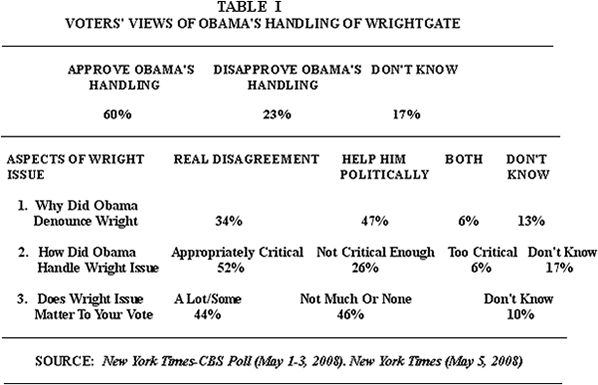
"disapprove” Obama's “handling of the Wright issue”, some 60% of voters responded “approve”, 23% “disapprove”, and 17% “don't know”.
When several aspects of the Wright issue were responded to, we gain from voters an operational sense of the impact of the Wright issue. First, a majority of voters (52%) viewed Obama's response to the Wright issue as “appropriately critical”, while 26% wanted stronger critical response by Obama. Furthermore, when asked how they viewed the possible impact of Obama's response on how they might vote, the voters' response was almost evenly divided between 44% who said “a lot or some” , and 46% who said “not much or none”.
The results of the survey of voters' attitudes toward Senator Obama's handling of the Wright issue suggest to me that several days before the North Carolina and Indiana primaries, there was what might be called a “middling-level voter satisfaction” with Obama's handling of Wrightgate”. Or put another way, the survey uncovered no “strong dissatisfaction” with Obama's handling of “Wrightgate”. One reason for this kind of “split-decision” response by voters on this issue might relate to the survey data shown in TABLE II.
These data measuring voters' views of the “candidates' honesty status”, were produced by the New York Times-CBS Poll (May 1-3, 2008). An interesting aspect of the data in TABLE II is that on the two measures of “more honest” and “less honest” than the average public figure, Senator Obama is viewed by American voters nearly twice as “more honest” than Senator Clinton (45% to 28%), and conversely Clinton is viewed as twice “less honest” than Obama (28% to 14%).
Thus, given what might be considered a base-line belief among American voters that Obama stands head-and-shoulder above Clinton on a variety of “honesty measures”, there's a proclivity among voters to give Obama the benefit-of-doubt regarding his handling of “Wrightgate”.
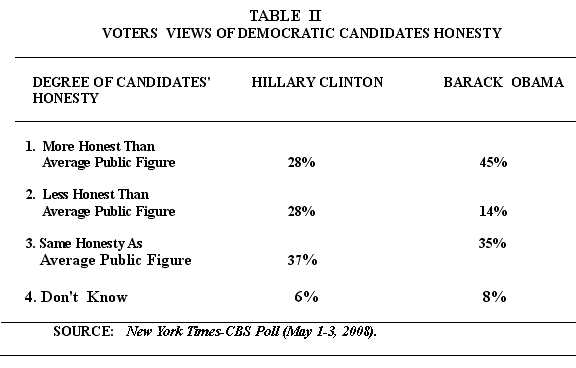
The first electoral test of this hypothesis occurred three days after the New York Times-CBS Poll, on May 6th when the North Carolina-Indiana elections occurred. In the New York Times (May 7, 2008) lead article on the North Carolina-Indiana elections, the impact of “Wrightgate” was characterized as follows:
The voting in Indiana and North Carolina came at the conclusion of an acrimonious two-week campaign that found Mr. Obama on the defensive over incendiary remarks by Mr. Wright. Yet there was little evidence either argument caused significant shifts in electoral patterns of previous states, with most Clinton voters saying the Wright episode affected their vote [57% in North Carolina] and Obama backers saying it did not [72% in North Carolina].
Aspects Of Voter Blocs In The North Carolina-Indiana Primaries
The overall results in the North Carolina-Indiana elections are shown in TABLE III. The first striking feature of the election results was the over 200,000-victory margin gained by Senator Barack Obama in North Carolina, which translated into 56% of the total votes compared to 41% for Senator Hillary Clinton. The significance of Obama's North Carolina
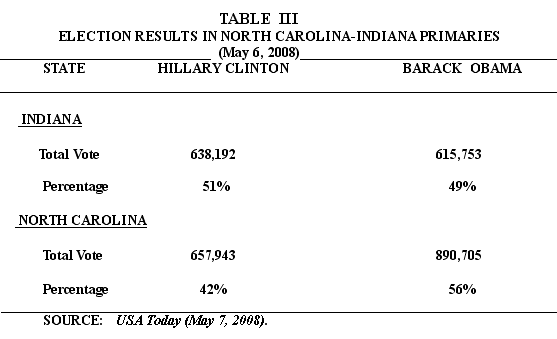
victory was candidly formulated in the lead article on the North Carolina-Indiana primaries in the Boston Globe (May 7, 2008) as follows: “With his solid win in North Carolina, Obama won more delegates on the night and he erased her [Clinton's] gain in popular votes from winning Pennsylvania's primary two weeks ago.” Another aspect of the significance of Obama's win in North Carolina, combined with Obama staying close to Clinton in her Indiana victory, concerned the “Wrightgate” issue.
It happened that key personalities in the national Democratic Party organization—especially superdelegates—had expressed concern whether the “Wrightgate” issue would have negative electoral effects, so Obama's 14-percentage point victory in North Carolina and Obama's staying close to Clinton in Indiana allayed those anxieties. In the New York Times (May 7, 2008) lead article on the North Carolina-Indiana elections, we were informed of the remarks by a leading Democratic Senator on this issue: “Senator Ben Nelson of Nebraska, an Obama supporter, said the candidate [Obama] accomplished what he needed to by outperforming expectations in both states and showing that Mr. Wright was not driving off voters en masse.”
Apart from the high double-digit range of Obama's victory in North Carolina and his electoral ability to stay close to Clinton's Indiana victory by 2-percentage points, another important aspect of the two primaries related to the voter blocs' candidate support pattern. Data from Exit Polls on voter blocs' candidate support pattern are shown in TABLE IV and in TABLE V.
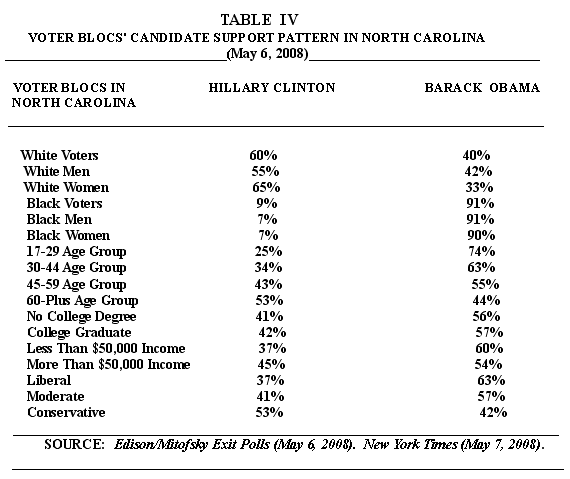
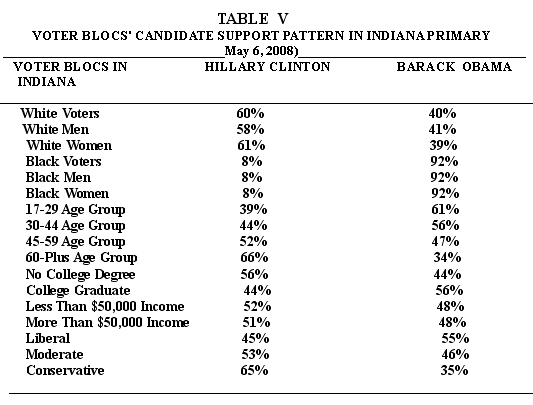
The data on voter blocs' candidate support pattern in the North Carolina and Indiana primaries parallel similar data for the Pennsylvania primary on April 22. Regarding the “age group” voter bloc, for example, whereas 61% of the 18-29 group backed Obama in Pennsylvania and 39 backed Clinton, in Indiana some 61% of the 17-29 group backed Obama and 39% backed Clinton. The next youngest “age group” voter bloc (30-44) backed Obama in Pennsylvania by 53% and 47% Clinton, and this “age group” voter bloc in Indiana backed Obama by 56% and 44% Clinton. It was among the 65-plus “age group” voter bloc that Clinton gained her strongest support in both Pennsylvania and Indiana—62% Clinton to 38% Obama in Pennsylvania, and 66% Clinton to 34% Obama in Indiana.
I have not located Exit Poll data regarding “ideological voter blocs” in the Pennsylvania primary, but TABLE IV and TABLE V provided such data for the North Carolina and Indiana primaries. These data struck me as especially interesting. First, although Obama gained a majority vote from the “liberal bloc” in both primaries (63% in North Carolina, 55% in Indiana), Obama gained a smaller share of the Indiana “liberal bloc”. Perhaps this “liberal bloc” vote pattern in North Carolina was related to the sizable proportion of Black voters in that primary—some 30% of Democratic voters were African-American.
Not surprisingly, however, the “conservative voter bloc” registered strong support for Clinton in both primaries—53% Clinton, 42% Obama in North Carolina; 65% Clinton, 35% Obama in Indiana. Nor was it a surprise that both White men and White women favored Clinton in both primaries. In Indiana, some 61% of White women backed Clinton, 39% Obama; in North Carolina, some 65% of White women backed Clinton, and a miniscule 33% Obama. However, Obama fared somewhat better among White men in both primaries. In North Carolina, 55% backed Clinton, 42% Obama; in Indiana, 58% backed Clinton, 41% Obama.
Conclusion: Note On Crucial Role Of Black Voter Bloc
In my fourth Black Commentator article (March 13, 2008) on the Obama campaign, I suggested that what might be called a “high Black-vote saturation for Obama” in key primary elections were crucial to the overall long-run electoral viability of the Obama campaign. I made this suggestion as follows in the context of the Maryland-Virginia-South Carolina-Wisconsin primaries:
..Special reference to the position of the Black vote in the [Maryland-Virginia-South Carolina-Wisconsin] election results is useful here. In the states of Maryland, Virginia, South Carolina, and Wisconsin, where Obama gained high double-digit victory margins, the Black vote for Obama was in the 85%-plus range. The Obama Campaign sustained the 85%-plus Black voter support in the Ohio primary—89% to be precise. And Obama gained 85% of Black voters in Texas. This might be dubbed a “Black voter-bloc saturation” of the Obama campaign.
The phenomenon of a “Black voter-bloc saturation” of the Obama campaign for the Democratic Party presidential nomination has been seen in subsequent primaries, including the April 22nd Pennsylvania primary and the May 6th North Carolina-Indiana primaries. In regard to the overall racial pattern, for example, 62% of Pennsylvania White voters favored Clinton and 38% favored Obama, while in both North Carolina and Indiana 60% of White voters backed Clinton in both states and 40% backed Obama.
An even stronger Black voter support favored Obama in all three states. Thus, some 91% of Blacks backed Obama in Pennsylvania, 91% backed Obama in North Carolina, and 92% backed Obama in Indiana. Given this “Black voter-bloc saturation” pattern, it was inevitable that the media has given special attention to it. Following is an example of such special attention as reported in The New York Times (May 7, 2008):
In North Carolina, Mr. Obama's performance was bolstered by a strong black vote. He captured more than 90 percent of those voters in that state, where blacks accounted for one in three [Democratic] voters.
Interestingly enough, newspapers, magazines, television networks, and other media on the conservative side of the political spectrum have reflected on what I call the “Black voter-bloc saturation” pattern in the Obama campaign as if the heavens are falling in, implying some kind of calamitous outcome for our country's political processes. Note, for example, the following reflection in the Wall Street Journal (May 7, 2008):
The [Obama] campaign's increasingly bitter focus on race is a turn-about from its start more than a year ago , when Sen. Obama promised to transcend the country's historic racial divisions as well as its political ones. The Illinois senator drew significant white support in this year's early contests. But his margins with white voters have grown smaller, and black voters have largely abandoned Sen. Clinton....
Now let me say that I find the foregoing reflections on the crucial role of the Black voter-bloc to the electoral success of the Obama campaign quite disingenuous. While a variety of White ethic groups evolved into political and electoral efficacy through, say, “Catholic voter-bloc, or Irish voter-bloc, or Italian voter-bloc, or Jewish voter-bloc saturation” vis-à-vis Irish-American candidates, Italian-American candidates, Jewish-American candidates, I don't recall the Wall Street Journal editors and commentators expressing high anxiety over this.
I don't recall that conservative newspapers and other conservative media suggesting that White-ethnic voter-blocs approximate a kind of illegitimacy in the American political scheme of things.
Accordingly, inasmuch as the Wall Street Journal and other conservative media today are suggesting that the Black-ethnic voter-bloc electoral patterns vis-à-vis the Obama campaign are approximating a kind of illegitimacy in American politics, such media are practicing a naked and cynical double-standard. It is also a dishonorable double standard, and as such should be discontinued.
BlackCommentator.com
Editorial Board member Martin Kilson, PhD hails from an African
Methodist background and clergy: From a great-great grandfather who
founded an African Methodist Episcopal church in Maryland in the 1840s;
from a great-grandfather AME clergyman; from a Civil War veteran great-grandfather
who founded an African Union Methodist Protestant church in Pennsylvania
in 1885; and from an African Methodist clergyman father who pastored
in an Eastern Pennsylvania mill town - Ambler, PA. He attended
(Harvard University Press, 1966); Key
Issues in the Afro-American Experience
(Harcourt Brace Jovanovich, 1970);
(Harvard University Press, 1975); The
African Diaspora: Interpretive Essays
(Harvard University Press, 1976); The Making of Black Intellectuals:
Studies on the African American Intelligentsia (Forthcoming.

